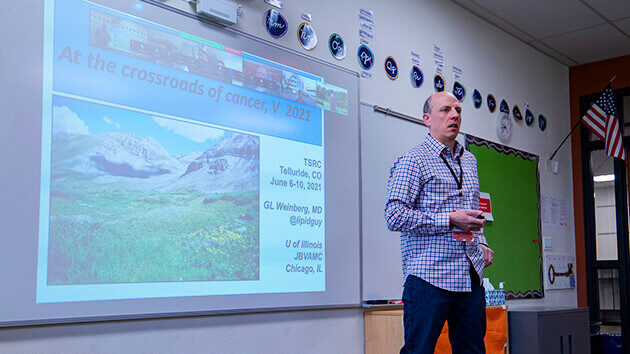Research at Albany Medical College Brings Attention to Rare Cancer

Scientists at Albany Medical College study many well-known diseases, including breast cancer, Alzheimer’s disease, hepatitis B, influenza, and heart disease.
They also research very rare diseases.
“It’s very motivating to know that the work you do could lead to new treatments for patients living with a cancer that very little is known about,” said John Lamar, PhD, associate professor in the Department of Molecular and Cellular Physiology.
In 2017, he began studying an exceedingly rare vascular tumor called epithelioid hemangioendothelioma, also known as EHE.
A type of sarcoma that grows from the cells that make up blood vessels, this deadly cancer most often occurs in people between the ages of 30 and 50 but can be diagnosed in patients of any age. It can occur anywhere in the body, but is most common in the liver, lungs, and bones.
Only one in one million people worldwide are known to be diagnosed with EHE, but since it’s so hard to identify, the number may be higher. Treatment is different for each person, depending on where EHE starts and if it has spread. In some cases, the tumor grows very slowly or not at all, but most EHEs eventually become aggressive.
“EHE often has a long indolent phase before becoming deadly, and with no effective treatments, patients are encouraged to wait until the cancer becomes aggressive before beginning chemotherapy,” explained Dr. Lamar.
“So they have to try to live a normal life, knowing they have a disease that will likely become life-threatening,” he added. “Since so few people research EHE, it’s hard for many patients to remain optimistic that new treatments will be developed.”
Dr. Lamar’s lab is one of the few in the world studying EHE.
His interest in it grew from his research on the role of two proteins, YAP and TAZ, in metastatic breast cancer and cutaneous melanoma. That led him to Dr. Guy Weinberg, an anesthesiologist at the University of Illinois, who founded a workshop to introduce EHE to leaders in the YAP/TAZ field. EHE is caused by a very specific mutation in either the YAP or TAZ protein.
Now co-directed by Drs. Lamar and Weinberg, this annual EHE workshop has played a significant role in increasing interest in and awareness of EHE. Since the first meeting six years ago, new researchers have begun to study EHE and the cancer is also now featured at many larger YAP/TAZ scientific conferences.
In 2019, Dr. Weinberg encouraged the EHE foundations in the UK, United States, and Australia to fund a small seed grant for an EHE pilot study in Dr. Lamar’s lab.
Since then, Dr. Lamar’s EHE research has been supported through significant grants, including, most recently, a $450,000 award from the EHE Foundation. This will enable the Lamar lab team to expand their work on identifying molecular pathways that can be targeted with existing FDA-approved drugs, which could then be quickly repurposed to help patients currently living with EHE.
“The EHE Foundation is an amazing organization and we are extremely grateful for their support of our research and for all that they do for EHE patients across the world,” said Dr. Lamar.
Dr. Lamar also regularly collaborates with Brian Rubin, PhD, a leading EHE researcher at the Cleveland Clinic. This partnership has yielded additional funding, including a grant from the Department of Defense.
And the team is working to advance knowledge of EHE within the research community.
Dr. Lamar and Albany Medical College graduate student Ryan Kanai have authored two collaborative papers stemming from their work, including one describing the first genetically engineered mouse model of EHE, a major advance in the field that provided the first in vivo EHE model system.
A third manuscript describing a mutation in a tumor suppressor gene that causes EHE to become more aggressive is undergoing revisions.
Dr. Lamar and Kanai have also given multiple presentations on the lab’s EHE research at scientific conferences and as invited speakers at other academic institutions.
In addition, Dr. Lamar and representatives from the EHE Foundation were invited to an event sponsored by the Chan Zuckerberg Initiative where they spoke about how partnerships between patient advocacy groups and researchers can benefit rare disease research.
“While there is still a lot of work to be done, the progress that has been made in the EHE field in the past few years is remarkable,” said Dr. Lamar. “I believe that if we can sustain this momentum, more effective EHE treatments are within our reach.”
